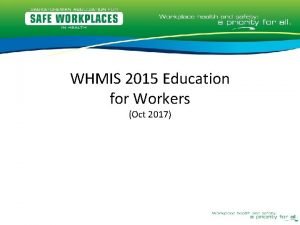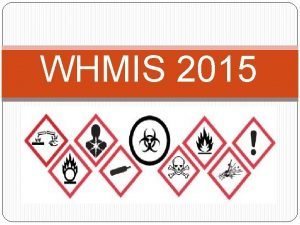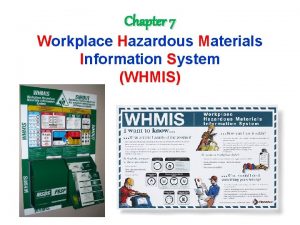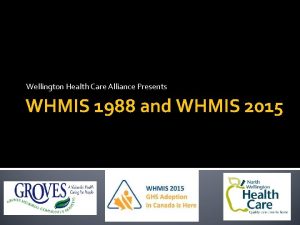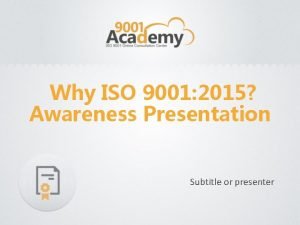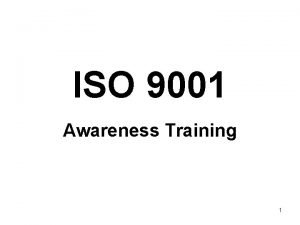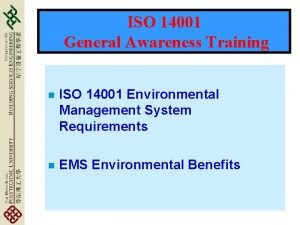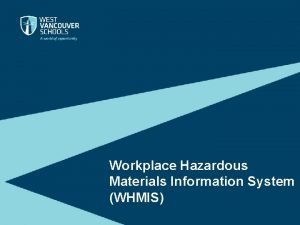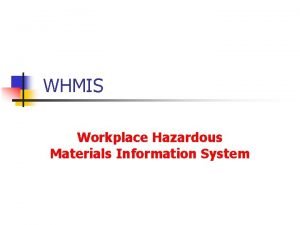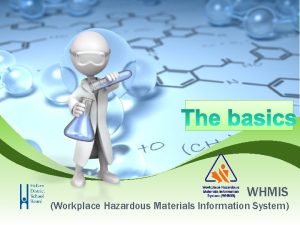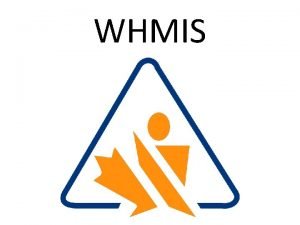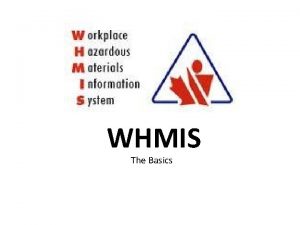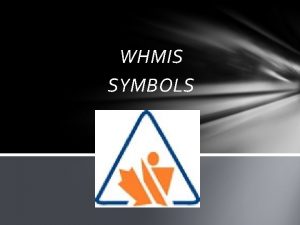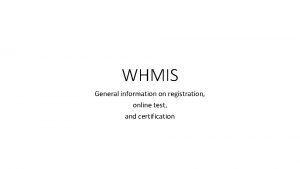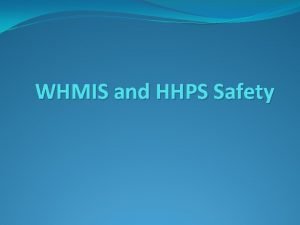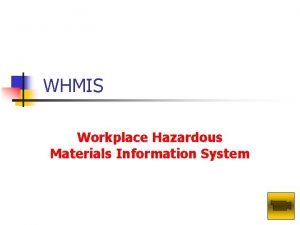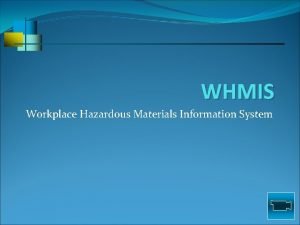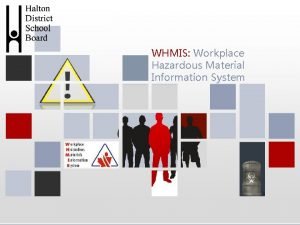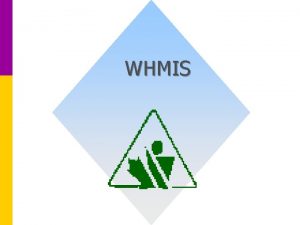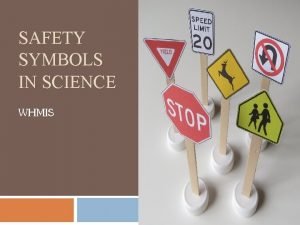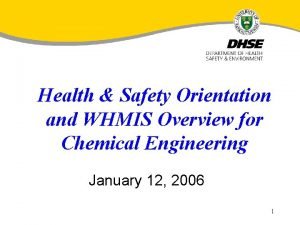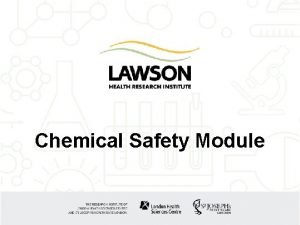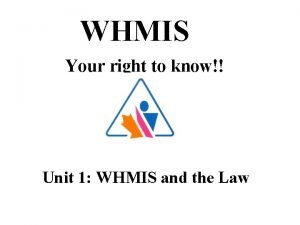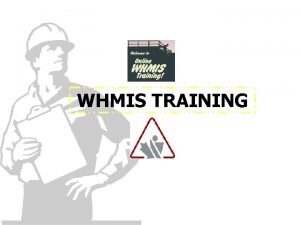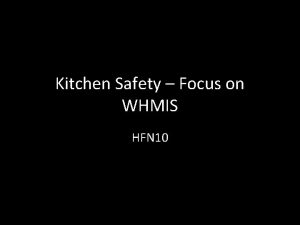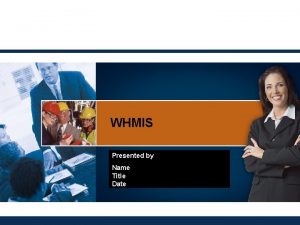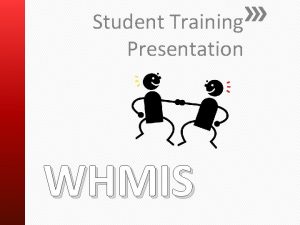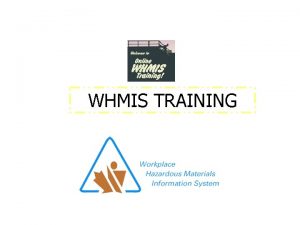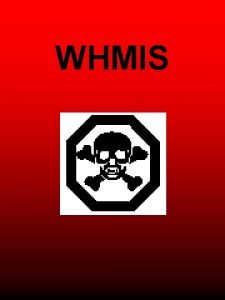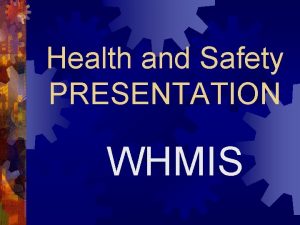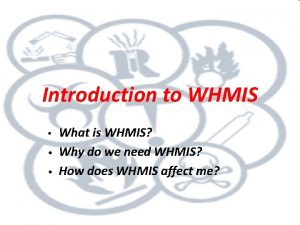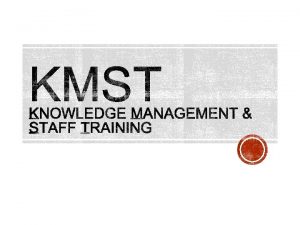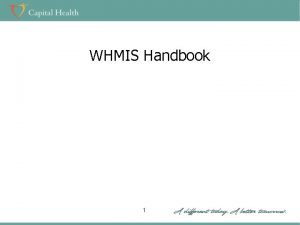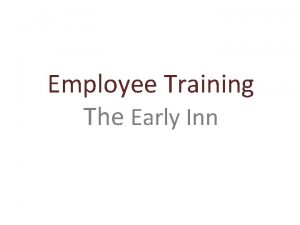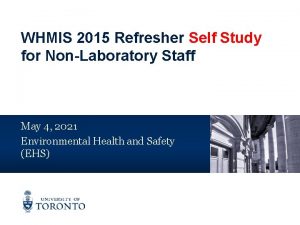WHMIS 2015 A TRAINING PROGRAM ON THE UPDATED














































































- Slides: 78

WHMIS 2015 A TRAINING PROGRAM ON THE UPDATED Workplace Hazardous Materials Information System www. eversafe. ca

Course Outline 01 Part 02 Part 03 Part 04 Part WHMIS Overview In part 1, we learn what WHMIS is an why it’s so important, chemicals and their adverse affects, legislation and WHMIS rights & responsibilities Routes of Entry, Hazard Classification & Pictograms Part 2 teaches us how chemicals can enter our bodies, hazard classification, WHMIS 1988 symbols and the new Pictograms Labels & Safety Data Sheets In part 3, we learn about supplier labels, workplace labels, WHMIS 1988 Material Safety Data Sheets and WHMIS 2015 Safety Data Sheets Education, Training & Safety Guidelines In the final part, we learn about education & training requirements, safeguarding control methods and safety guidelines

Part 1 Legislation, Responsibilities, Chemicals Overview and Health Effects → WHMIS Overview → Legislation → Chemical Overview → Health Effects → Rights and Responsibilities 3

WHMIS INTRODUCTION 4

WHMIS Overview The Right for Workers to Know WHMIS first came into effect on October 31, 1988. It was created to address the rights of Canadian workers, to know about health and safety hazards associated with chemicals that they use or may come in contact with in the workplace. 5

WHMIS Overview WHMIS Adopts GHS → In February 2015, Canada aligned WHMIS with the Globally Harmonized System of Classification and Labeling of Chemicals. → GHS was developed as an international initiative to bring global standardization to chemical hazard classification and communication. → While the adoption of GHS has resulted in some changes to the Workplace Hazardous Materials Information System, it offers the same, if not additional protection to workers.

WHMIS Overview Introducing WHMIS 2015 → The aligned system is now referred to as WHMIS 2015.

WHMIS Overview The Differences → The main differences that you'll notice are that the symbols will look slightly different and that the 9 section Material Safety Data Sheets are being replaced with the 16 section Safety Data Sheets Is now this

WHMIS Overview Transition Period → Because there is a transitional period that will last several years, it's likely that workers will encounter elements from both the original WHMIS (WHMIS 1988) and the new, GHS aligned WHMIS (WHMIS 2015) → It's for this reason that all Canadian workers need to be familiar with both systems in order to properly protect themselves

Transition Period WHMIS Overview Manufacturers, importers and distributors must comply with WHMIS 1988 or WHMIS 2015 (CPR or HPR). They cannot use a combination of both systems. Phase 2 June 1, 2017 to May 31, 2018 2 Manufacturers, importers and distributors must comply with the new requirements. They cannot use a combination of both systems. Employers may still see remnants of both systems in their workplaces. Completion 1 Phase 1 February 2015 – May 31, 2017 Manufacturers and importers must comply with the new requirements. Distributors must comply with WHMIS 1988 or WHMIS 2015 (CPR or HPR). They cannot use a combination of both systems 3 Phase 3 June 1, 2018 – November 30, 2018 By December 21, 2018, Manufacturers, importers, distributors and employers must fully be transitioned to the 10 new WHMIS 2015 system. No elements of the old system should be found within workplaces.

WHMIS Overview LABELS The purpose of WHMIS labels are to warn workers that there are potential hazards with the materials which the labels reside on and to provide information on how to eliminate or significantly reduce those hazards. SAFETY DATA SHEETS EDUCATION & TRAINING Material Safety Data Sheets and Safety Data sheets give additional detailed technical information about the hazardous material. Workers must participate in WHMIS education and training programs. These programs must include general knowledge and WHMIS fundamentals as well as specific information and protective measures pertaining to the actual workplace. The Three Parts of WHMIS 11

LEGISLATION 12

Legislation Federal and Provincial Law → The main purpose of the federal WHMIS legislation is to require the suppliers of hazardous materials used in the workplace to provide health and safety information about their products as a condition of sale. → The main purpose of the provincial WHMIS legislation is to require employers to obtain health and safety information about hazardous materials in the workplace and to pass this information on to workers.

Health Effects 14

Health Effects Adverse Health Effects → Adverse effects can range from minor reversible effects to severe effects which are irreversible.

Health Effects Type of Health Effects → Acute Health Effects happen quickly, usually a short time after exposure → Chronic Health Effects happen slowly over time.

Health Effects Examples of Health Effects Acute Chronic è Damage to tissue è Irritation è Dry skin è Dermatitis è Allergic reactions è Lethal dosage è Cancer è Asbestosis è Mesothelioma è Silicosis è Hearing loss è Chronic dermatitis

Chemical Overview 18

Chemical Overview Type of Health Effects → We know that working with chemicals can be hazardous. → Chemicals are not all the same and have very different characteristics

Chemical Overview Solids The term "Solid" is one of the states of matter. It's characterized by rigidity and it's resistance to changes of volume and state. Chemicals in a solid state do not flow or completely take the shape of their containers. The density of solids can vary dramatically which affects their perceived mass and weight.

Chemical Overview Liquids The term "liquid" is also one of the states of matter. The particles in a liquid are free to flow, so while a liquid has a definite volume, it does not have a definite shape. Chemicals in a liquid state flow and completely take the shape of their containers.

Chemical Overview Gases The term "Gas" is one of the 3 states of matter. It is characterized by its low density. In the gaseous phase, atoms are spread apart as opposed to liquids and solids where atoms are more compact. Some chemicals change into their gaseous state based on environmental variables such as temperature and pressure.

Chemical Overview Containers Chemicals can be found in various types of vessels, cans, boxes, drums, bottles, tanks and pressure vessels. Really, there are no specific "packaging" requirements which would indicate that a hazardous chemical is contained within. It's for this reason that we must always consider that any type of container or package in the workplace may contain some type of chemical.

Rights & Responsibilities 24

Rights & Responsibilities WHMIS legislation defines that there are typically three primary parties which are required to adhere to particular responsibilities pertaining to WHMIS. → The Supplier → The Buyer → The Workers

Rights & Responsibilities Suppliers generally manufacture or import hazardous materials into the country for the purpose of selling them. They are the companies that your employer buys the chemicals from. → Provide a supplier label for every hazardous product that they import or bring in to the country → Provide an SDS (Safety Data Sheet) for every hazardous material they import or manufacture → Provide an MSDS (Material Safety Data Sheet) for every hazardous material they import or manufacture

Rights & Responsibilities Buyer Responsibilities In this particular situation, the buyer refers to your employer; the organization that buys the hazardous materials for use in its workplace. → In this particular situation, the buyer refers to your employer; the organization that buys the hazardous materials for use in its workplace. → Ensure that Safety Data Sheets are easy for workers to find and read → Ensure that all containers of hazardous materials in the workplace are labeled → Provide training on WHMIS in consultation with the Joint Health and Safety Committee or a health and safety representative

Rights & Responsibilities Worker Responsibilities We’ve all heard the analogy of how the strength of each individual link in a chain will dictate the strength of the entire chain. Workers are a valuable link in this critical chain of Health and Safety also have responsibilities and rights that are very important. → Participate in WHMIS training → Use their knowledge of WHMIS to work as safety as possible

Rights & Responsibilities Worker Rights In addition to their WHMIS responsibilities, workers also have specific rights that include: → Refuse work that they believe is dangerous → Know about the hazardous materials that they work with → Consult with the Joint Health and Safety Committee or the Health and Safety Representative

Rights & Responsibilities Partnership In order to maintain an effective WHMIS program, all three responsible parties must work together as a team. Commitment, communication and a solid safety culture will ensure that the information that you need is available when it's most important.

Part 2 Routes of Entry, Hazard Classification, Symbols & Pictograms → Routes of Entry → Hazard Classification & WHMIS 1988 Symbols → WHMIS 2015 Pictograms 31

Routes of Entry 32

Routes of Entry How Can Chemical Enter the Body? In order for a chemical to become hazardous to a person's health, it must first contact or enter the body and the chemical must have some biological effect on the body. There are four primary Routes of Entry.

Routes of Entry Inhalation may be the most common way in which hazardous materials can enter your body. Dust, mist, fumes and vapors can be inhaled in through your nose or mouth and travel into your lungs where they can begin to cause damage and even enter into your blood stream.

Routes of Entry Ingestion Chemicals can easily be absorbed through your digestive system. This can occur if you have hazardous materials on your hands while eating or smoking. It's also possible to swallow chemicals if food is left uncovered in areas where there is a risk of exposure to the chemicals.

Routes of Entry Absorption Some hazardous materials can also enter your body by passing through your skin. The severity of the harm also varies drastically depending on what type of chemical has contacted you. Some hazardous materials will cause your skin to become very sensitive, while others may pass directly through the skin and into the blood stream.

Routes of Entry Injection Chemicals can enter the body and particularly the bloodstream through lacerations, punctures or syringe needles.

Hazard Classification & Symbols/Pictograms 38

Hazard Classification & Symbols/Pictograms Symbols → Even if you are just entering into the workforce, it’s very likely that you have already seen some of the WHMIS symbols that we’re going to talk about → These symbols can sometimes be found on household products that you buy often, and possibly use on a regular basis.

Hazard Classification & Symbols/Pictograms What do Symbols/Pictograms Mean? → WHMIS 2015 doesn’t change the fact that symbols quickly communicate the dangers associated with a product to those working with or around hazardous materials → The difference is, now the symbols look slightly different and there’s a few more of them that workers may not recognize

Hazard Classification & Symbols/Pictograms Gas Cylinder Flame Over Circle Corrosion Skull & Crossbones Exclamation Mark Health Hazard Exploding Bomb Environmental Hazard Biohazardous Infectious Material

Hazard Classification & Symbols/Pictograms Gas Cylinder The gas cylinder pictogram/symbol indicates gases under pressure including compressed gas, liquefied gas, refrigerated liquefied gas and dissolved gas. All compressed gases are hazardous because of the high pressures inside the cylinders. Even at a relatively low pressure, gas can flow rapidly from an open or leaking cylinder.

Hazard Classification & Symbols/Pictograms Flame This pictogram/symbol indicates that the materials are flammable. Flammable substances can ignite very easily and will burn very vigorously when ignited. You must exercise extreme caution while working with or around flammable materials and keep them away from ignition sources.

Hazard Classification & Symbols/Pictograms Flame Over Circle Materials bearing this pictogram/symbol are considered oxidizing substances. While not flammable on their own, materials in this classification will provide the oxygen necessary to fuel fires. Oxidizing materials are not limited to one state of matter, but can be in the form of liquids, solids and gases.

Hazard Classification & Symbols/Pictograms Corrosion This pictogram/symbol indicates that the materials can cause corrosive damage to metals, as well as skin and eyes. Damage caused by these chemicals is usually permanent. Significant precautions should always be taken to ensure corrosive materials do not come in contact with unprotected parts of your body.

Hazard Classification & Symbols/Pictograms Skull & Crossbones The skull and crossbones indicates that a substance is toxic. Toxic substance have the ability to harm or kill living organisms if ingested or inhaled. Additionally, these substances can cause problems with the respiratory system, leading to breathing difficulties that can result in death.

Hazard Classification & Symbols/Pictograms Exclamation Mark This new pictogram let's the user of a product know that the chemical is an irritant. These substances typically cause soreness or redness to the skin and cause it to become irritated It should be noted that irritant substances are not harmless as they have the ability to cause acute toxicity if inhaled or ingested.

Hazard Classification & Symbols/Pictograms Health Hazard Substances bearing this pictogram can pose several health hazards and have the ability to physically damage or potentially kill an animal or human. These substances should never be inhaled or ingested under any circumstances.

Hazard Classification & Symbols/Pictograms Exploding Bomb This new pictogram and WHMIS 1988 symbol indicate that the materials are explosive or highly reactive; quite simply these products can be self reactive and have the ability to explode if handle improperly.

Hazard Classification & Symbols/Pictograms Biohazardous Infectious Material This WHMIS symbols has not changed and means the same thing. These materials are organisms or the toxins which they produce that can cause diseases in people or animals.

Hazard Classification & Symbols/Pictograms Environmental Damaging Substances within this pictogram have the ability to kill or damage living things within an ecosystem or environment.

Part 3 Labels & Safety Data Sheets → Labels → Material Safety Data Sheets → Safety Data Sheets 52

Labels 53

Labels The Importance of Labels. → WHMIS Labels are extremely important because they are typically the first indication to an individual that there may be certain risks when working with a controlled product → WHMIS Labels also indicate what precautions need to be taken in order for an employee to protect themselves from illness or injury while working with a particular chemical.

Labels on Containers. → WHMIS legislation requires that every container of hazardous materials be labeled → Employers are responsible for ensuring that all containers display the correct labeling throughout the workplace

Labels Supplier Labels → Suppliers are required to provide supplier labels to all parties who purchase controlled products from them. These materials should not be accepted unless a label is available

Labels Information on Supplier Labels → Product Identifier → Initial Supplier Identifier → Pictograms → Signal Words → Hazard Statement(s) → Precautionary Statement(s) → Supplemental Label Information Supplier labels must be written in English and French. They may be bilingual (as one label), or available as two labels (one each in English and French)

Labels Workplace Labels → Employers are required to ensure that all hazardous materials in the workplace contain a workplace label displaying the correct information

Labels Information on Workplace Labels → Product Name (matching the SDS) → Safe Handling Precautions → A Reference to the Safety Data Sheets Workplace label requirements fall under provincial or territorial jurisdiction, or under the Canada Labour Code in a federally regulated workplace. Additional information may be required to be displayed on a workplace label other than the information above.

Safety Data Sheets 60

Safety Data Sheets → A Safety Data Sheet (SDS) is a document that contains specific technical information about a particular product → The SDS contains much more information about the material than the label

Safety Data Sheets → A Safety Data Sheet (SDS) is a document that contains specific technical information about a particular product → The SDS contains much more information about the material than the label → Safety Data Sheets contain 16 sections where as WHMIS 1988 Material Safety Data Sheets only contain nine

Information Contained in the Sections of a Safety Data Sheet 1 of 2 1. Identification Identifies the chemical on the SDS as well as it’s recommended uses. It also provides the essential contact information of the supplier. 3. Information/Composition on Ingredients Identifies the ingredient(s) contained in the product indicated on the SDS, including impurities and stabilizing additives. 5. Fire Fighting Measures Provides recommendations for fighting a fire caused by the chemical. 7. Handling and Storage Provides guidance on the safe handling practices and conditions for safe storage of chemicals. 2. Hazard Identification Identifies the hazards of the chemical presented on the SDS and the appropriate warning information associated with those hazards. 4. First Aid Measures Describes the initial care that should be given by untrained responders to an individual who has been exposed to the chemical. 6. Accidental Release Measures Provides recommendations on the appropriate response to spills, leaks, or releases, including containment and cleanup practices to prevent or minimize exposure. 8. Exposure Controls / Personal Protection Indicates the exposure limits, engineering controls, and personal protective measures that can be used to minimize worker exposure. Every product that is classified as a “hazardous product” under WHMIS that is intended for use, handling or storage in a 63 workplace in Canada must have an SDS.

Information Contained in the Sections of a Safety Data Sheet 2 of 2 9. Physical and Chemical Properties Identifies physical and chemical properties associated with the substance or mixture 11. Toxicological Information Identifies toxicological and health effects information or indicates that such data are not available. 13. Disposal Considerations Provides guidance on proper disposal practices, recycling or reclamation of the chemical(s) or its container, and safe handling practices. 15. Regulatory Information Identifies the safety, health, and environmental regulations specific for the product that is not indicated anywhere else on the SDS 10. Stability and Reactivity Describes the reactivity hazards of the chemical and the chemical stability information. This section is broken into three parts: reactivity, chemical stability, and other. 12. Ecological Information Provides information to evaluate the environmental impact of the chemical(s) if it were released to the environment. 14. Transport Information Provides guidance on classification information for shipping and transporting of hazardous chemical(s) by road, air, rail, or sea. 16. Other Information Indicates when the SDS was prepared or when the last known revision was made. The SDS may also state where the changes have been made to the previous version. You may wish to contact the supplier for an explanation of the changes. Every product that is classified as a “hazardous product” under WHMIS that is intended for use, handling or storage in a 64 workplace in Canada must have an SDS.

Part 4 Education, Training and Safety Guidelines →Education & Training →General Safety →Safety Guidelines 65

Education & Training 66

Education & Training Workers → Adequate Education and Training is fundamental in ensuring that WHMIS works → Any employer who has potentially Hazardous Materials in their workplace, must ensure that employees who may be exposed to those materials are adequately trained → There are two types of WHMIS training that must be satisfied

Types of WHMIS Training General WHMIS Training Workplace Specific Training Employees who may come in contact with or work around Hazardous Materials, must receive General WHMIS Training. Because conditions and circumstances can vary significantly between workplaces, additional work site specific training is usually required in addition to general training. Typical Topics Include: → What WHMIS is and how it affects you → Specific safety precautions → Information about labels → Emergency procedures → How chemicals can enter your body → Handling and use requirements → Fundamentals for controlling risk → Required PPE → How to read Safety Data Sheets → Specialized policies and procedures → General protective measures Sometimes General WHMIS Training is referred to as WHMIS Education. 68

Protective Measures & Safety Guidelines 69

Protective Measures & Safety Guidelines The Hierarchy of Safeguarding Controls is a system used in industry to minimize or eliminate exposure to hazards; in this case, chemical hazards. The hazard controls in the hierarchy are, in order of decreasing effectiveness. → → → Elimination/Substitution Engineering Administration Hygiene Personal Protective Equipment Hygiene is not typically considered a separate category on a general hierarchy, but has been added under the circumstances because it’s directly applicable to chemical hazards.

Types of Safeguarding Controls Elimination or Substitution Engineering If a process that uses a hazardous chemical can be eliminated entirely, then the hazard will effectively no longer exist. Engineering controls are used to remove a hazard or place a "barrier" between the worker and the hazard. This can be done using several methods including automating a process, thereby eliminating the need for an employee to come in contact a hazardous product. Well-designed engineering controls can be highly effective in protecting workers and will typically be independent of worker interactions to provide this high level of protection. Similarly, if substitutions can be made, which mitigate the hazard entirely, the control is equally as effective as elimination. Engineered ventilation systems can provide exceptional protection from certain chemical exposure. Administration Administrative Controls include work practices, policies, procedures, training and other guidelines that individuals must follow. While these may be less effective than eliminating the hazard altogether, they are an extremely important element in reducing the likelihood of an incident occurring. Several specific prevention techniques that are considered administrative controls are discussed throughout this training program. Hygiene Practicing good personal hygiene reduces the probability of toxic materials entering the body and even carrying the substance outside of the workplace. You should always wash thoroughly after being in situations where a possibility of exposure exists. PPE should not be worn outside of your work area to reduce the likelihood of transferring any harmful substance into other environments. PPE (Personal Protective Equipment) Personal protective equipment (PPE) can be considered a “last line of defense” in protecting oneself from the hazards associated with exposure to harmful chemicals. PPE includes important items such as safety glasses, respirators, gloves, face shields, coveralls and safety boots. Personal Protective Equipment should fit properly, be maintained regularly, and all employees should be trained in its proper storage, maintenance and use.

Protective Measures & Safety Guidelines Now that we know about the safeguarding control methods, let’s review some of the specific safety guidelines that must be followed in order to protect yourself while working with hazardous materials.

Protective Measures & Safety Guidelines (1 of 3) → Ensure that compressed gas cylinder caps are in place and secured prior to and during transport → Always use properly designed carriers for transporting and handling compressed gas cylinders → Cylinders must be stored in a cool, dry place and should always be secured to prevent tipping or falling → Ensure that connections are properly secured before attempting to open valves on compressed gas cylinders and ensure that all valves are closed before removing connections → Ensure that containers are properly grounded and bonded when pouring flammable liquids to avoid the detrimental effects of sparks creating an ignition source → Avoid ignition sources such as flames, smoking, sparks and hot sources when working with flammables

Protective Measures & Safety Guidelines (2 of 3) → Avoid oxidizers when working with flammable materials as they provide oxygen and will promote burning → Flammable materials should only be stored in approved storage containers and cabinets → Oxidizing substances should always be kept away from ignition sources → Always wear the proper personal protective equipment when working with hazardous materials → Never made direct contact with toxic or corrosive materials → Materials should always be handled and stored in designated areas only → Ensure that hazardous materials are cleaned up and disposed of properly so that traces are not left in areas and on surfaces where they can harm you and others → Ensure that all containers and storage devices are closed securely to avoid accidental release

Protective Measures & Safety Guidelines (3 of 3) → Always follow workplace specific policies, procedures and guidelines → If you don’t understand a hazard or how to work safely, ask your supervisor → Never take short cuts → Ensure that all containers of hazards materials contain a proper label → Always review a products Safety Data Sheet prior to using it → Do not use a chemical unless an up to date Safety Data Sheet is available for review

Quiz 76

End of Course QUESTIONS OR COMMENTS? 77

Workplace Safety Training and Development Solutions www. eversafe. ca
 2 types of whmis labels
2 types of whmis labels Whmis quiz answers 2015
Whmis quiz answers 2015 Whmis with ghs stands for
Whmis with ghs stands for What shape and color are the whmis 2015 symbols
What shape and color are the whmis 2015 symbols Whmis 1988 vs 2015
Whmis 1988 vs 2015 During _______ branching, only car is updated with adr
During _______ branching, only car is updated with adr Monitoring and mentoring ssp
Monitoring and mentoring ssp Iso 9001:2015 awareness presentation ppt
Iso 9001:2015 awareness presentation ppt Iso 9001 presentation
Iso 9001 presentation Iso 14001 awareness training
Iso 14001 awareness training Hát kết hợp bộ gõ cơ thể
Hát kết hợp bộ gõ cơ thể Lp html
Lp html Bổ thể
Bổ thể Tỉ lệ cơ thể trẻ em
Tỉ lệ cơ thể trẻ em Voi kéo gỗ như thế nào
Voi kéo gỗ như thế nào Thang điểm glasgow
Thang điểm glasgow Chúa yêu trần thế
Chúa yêu trần thế Môn thể thao bắt đầu bằng từ đua
Môn thể thao bắt đầu bằng từ đua Thế nào là hệ số cao nhất
Thế nào là hệ số cao nhất Các châu lục và đại dương trên thế giới
Các châu lục và đại dương trên thế giới Công thức tính thế năng
Công thức tính thế năng Trời xanh đây là của chúng ta thể thơ
Trời xanh đây là của chúng ta thể thơ Cách giải mật thư tọa độ
Cách giải mật thư tọa độ 101012 bằng
101012 bằng Phản ứng thế ankan
Phản ứng thế ankan Các châu lục và đại dương trên thế giới
Các châu lục và đại dương trên thế giới Thể thơ truyền thống
Thể thơ truyền thống Quá trình desamine hóa có thể tạo ra
Quá trình desamine hóa có thể tạo ra Một số thể thơ truyền thống
Một số thể thơ truyền thống Cái miệng xinh xinh thế chỉ nói điều hay thôi
Cái miệng xinh xinh thế chỉ nói điều hay thôi Vẽ hình chiếu vuông góc của vật thể sau
Vẽ hình chiếu vuông góc của vật thể sau Biện pháp chống mỏi cơ
Biện pháp chống mỏi cơ đặc điểm cơ thể của người tối cổ
đặc điểm cơ thể của người tối cổ V. c c
V. c c Vẽ hình chiếu đứng bằng cạnh của vật thể
Vẽ hình chiếu đứng bằng cạnh của vật thể Fecboak
Fecboak Thẻ vin
Thẻ vin đại từ thay thế
đại từ thay thế điện thế nghỉ
điện thế nghỉ Tư thế ngồi viết
Tư thế ngồi viết Diễn thế sinh thái là
Diễn thế sinh thái là Dot
Dot Số nguyên là gì
Số nguyên là gì Tư thế ngồi viết
Tư thế ngồi viết Lời thề hippocrates
Lời thề hippocrates Thiếu nhi thế giới liên hoan
Thiếu nhi thế giới liên hoan ưu thế lai là gì
ưu thế lai là gì Khi nào hổ mẹ dạy hổ con săn mồi
Khi nào hổ mẹ dạy hổ con săn mồi Sự nuôi và dạy con của hươu
Sự nuôi và dạy con của hươu Sơ đồ cơ thể người
Sơ đồ cơ thể người Từ ngữ thể hiện lòng nhân hậu
Từ ngữ thể hiện lòng nhân hậu Thế nào là mạng điện lắp đặt kiểu nổi
Thế nào là mạng điện lắp đặt kiểu nổi Msds
Msds Hazardous chemicals
Hazardous chemicals Technical bulletins whmis
Technical bulletins whmis What do whmis stand for
What do whmis stand for Technical bulletins whmis
Technical bulletins whmis Whmis symbols t
Whmis symbols t Whmis mcgill
Whmis mcgill Household safety symbols
Household safety symbols Hhps borders
Hhps borders Whmis building blocks
Whmis building blocks Whmis precautionary statement
Whmis precautionary statement What is hhps
What is hhps Whmis r with test tube
Whmis r with test tube Whmis r with test tube
Whmis r with test tube Technical bulletins whmis
Technical bulletins whmis What is the purpose of whmis
What is the purpose of whmis What does whmis stand for in science
What does whmis stand for in science Whmis overview
Whmis overview Whmis describes the nature of the hazard
Whmis describes the nature of the hazard Flammable whmis
Flammable whmis Blank whmis labels
Blank whmis labels 3 basic components of whmis
3 basic components of whmis Hazmat for dummies
Hazmat for dummies Hfn10
Hfn10 Training is expensive without training it is more expensive
Training is expensive without training it is more expensive Perbedaan on the job training dan off the job training
Perbedaan on the job training dan off the job training Aggression replacement training facilitator training
Aggression replacement training facilitator training

